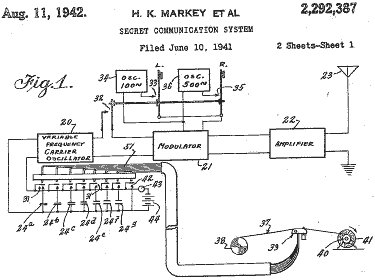Hedy Lamarr: Actress and Inventor
|
Share This Page
|
|
|
|
|
|
|
Follow This Site

|
 |
|
|
Hedy Lamarr, well known as an actress, was also an inventor. And her invention forms the basis of much of today's communications technology.
 Lamarr was born in Austria. (Her birth name was Hedwig Kiesler.) She first appeared in films when she was 18, in 1933. Married at 19, she appeared in a few more films in Europe and then made her way to Hollywood, where she became one of the most famous actresses of her generation, starring opposite such famous leading men as Clark Gable, John Garfield, Spencer Tracy, and Robert Young. Her most famous screen role was the title role in Samson and Delilah, directed by famed spectacle-lover Cecil B. DeMille.
Lamarr was born in Austria. (Her birth name was Hedwig Kiesler.) She first appeared in films when she was 18, in 1933. Married at 19, she appeared in a few more films in Europe and then made her way to Hollywood, where she became one of the most famous actresses of her generation, starring opposite such famous leading men as Clark Gable, John Garfield, Spencer Tracy, and Robert Young. Her most famous screen role was the title role in Samson and Delilah, directed by famed spectacle-lover Cecil B. DeMille.
 Lamarr was also a keen scientist and inventor. When she was living in California during World War II, she and neighbor George Antheil, a composer, discussed ways of adapting Antheil's method of controlling musical instruments for use in avoiding the jamming of radio-controlled torpedoes and missiles. The two devised a method of transmission called frequency-hopping, a method of changing the frequency of a signal from a submarine control center and the outgoing torpedo up to 88 times in order to prevent jamming. The musician Antheil chose the number 88 partly because of his love for the piano, which has 88 keys. The control mechanism was a device that resembled a player piano.
Lamarr was also a keen scientist and inventor. When she was living in California during World War II, she and neighbor George Antheil, a composer, discussed ways of adapting Antheil's method of controlling musical instruments for use in avoiding the jamming of radio-controlled torpedoes and missiles. The two devised a method of transmission called frequency-hopping, a method of changing the frequency of a signal from a submarine control center and the outgoing torpedo up to 88 times in order to prevent jamming. The musician Antheil chose the number 88 partly because of his love for the piano, which has 88 keys. The control mechanism was a device that resembled a player piano.
Lamarr and Antheil secured a patent for their technology in 1942. But the U.S. Navy wasn't much of a fan of the idea and so did not implement it right away. The patent had expired by the time the Navy did use the technology, during the Cuban Missile Crisis, so neither Lamarr nor Antheil got anything out of the use.
However, the idea now forms the basis of much of modern wireless communications technology, notably fax machines, Bluetooth, and CDMA (a popular wireless telephone protocol). It is routinely called spread spectrum technology or frequency-hopping.



 Lamarr was born in Austria. (Her birth name was Hedwig Kiesler.) She first appeared in films when she was 18, in 1933. Married at 19, she appeared in a few more films in Europe and then made her way to Hollywood, where she became one of the most famous actresses of her generation, starring opposite such famous leading men as Clark Gable, John Garfield, Spencer Tracy, and Robert Young. Her most famous screen role was the title role in Samson and Delilah, directed by famed spectacle-lover Cecil B. DeMille.
Lamarr was born in Austria. (Her birth name was Hedwig Kiesler.) She first appeared in films when she was 18, in 1933. Married at 19, she appeared in a few more films in Europe and then made her way to Hollywood, where she became one of the most famous actresses of her generation, starring opposite such famous leading men as Clark Gable, John Garfield, Spencer Tracy, and Robert Young. Her most famous screen role was the title role in Samson and Delilah, directed by famed spectacle-lover Cecil B. DeMille. Lamarr was also a keen scientist and inventor. When she was living in California during World War II, she and neighbor George Antheil, a composer, discussed ways of adapting Antheil's method of controlling musical instruments for use in avoiding the jamming of radio-controlled torpedoes and missiles. The two devised a method of transmission called frequency-hopping, a method of changing the frequency of a signal from a submarine control center and the outgoing torpedo up to 88 times in order to prevent jamming. The musician Antheil chose the number 88 partly because of his love for the piano, which has 88 keys. The control mechanism was a device that resembled a player piano.
Lamarr was also a keen scientist and inventor. When she was living in California during World War II, she and neighbor George Antheil, a composer, discussed ways of adapting Antheil's method of controlling musical instruments for use in avoiding the jamming of radio-controlled torpedoes and missiles. The two devised a method of transmission called frequency-hopping, a method of changing the frequency of a signal from a submarine control center and the outgoing torpedo up to 88 times in order to prevent jamming. The musician Antheil chose the number 88 partly because of his love for the piano, which has 88 keys. The control mechanism was a device that resembled a player piano.
